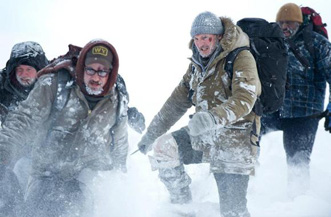Movie Review: The Grey
By Matthew Huntley
February 2, 2012
BoxOfficeProphets.com

The Grey is a different kind of thriller because it does everything in its power to make us NOT want to be the characters. It sees them and their situation through a grim and realistic lens, versus one that’s heightened by romanticism, contrived plot devices or a comfortable certainty of knowing what’s going to happen. All these qualities make it uncommonly dramatic and powerful.
From the first frame, the story puts its people in a cold state of misery that we’re thankful not to be a part of, even though the atmosphere is so palpable it forces us to empathize with them and nearly affects us physically. In a frozen, whited out region of Alaska, Ottway (Liam Neeson) is one of the many rough, lonely and angry men who works for an oil drilling team, among them ex-cons that society would like to pretend don’t exist. Ottway’s job is to protect the parameter from the surrounding wolves. He carries around a sniper rifle and keeps a watchful eye, though his duties bring him little pleasure and he’s on the verge of suicide because he mourns the relationship he had with his wife (Anne Openshaw).
On a flight back to the mainland, the plane crashes (in an eerily authentic sequence) and leaves Ottway and various other survivors stranded. Threatening their lives are not only the freezing temperatures and lack of food and shelter, but a pack of wolves that is gradually moving in. Because Ottway is a man who understands a wolf’s nature, he explains to Hendrick (Dallas Roberts), Diaz (Frank Grillo), Talget (Dermot Mulroney), Burke (Nonso Anozie), Flannery (Joe Anderson) and Hernandez (Ben Bray) that they’ve entered the animals’ territory, which can be as vast as a 30-mile radius. Their den may not be far off, and to keep the wolves at bay, it’s important the men surround themselves with fires, stay together and make their way toward sylvan surroundings.
Given what I just told you, it would be all too easy to label The Grey as just another one of those “man vs. nature/survival” movies, and while it does fit that description to a degree, it tries hard to go against the grains of convention. There are some inevitable developments, like one member of the group trying to play the tough guy and another trying to be the jokester, and we can also anticipate certain deaths. On the other hand, the movie avoids the pitfalls of lazy plot devices. For instance, Ottway teaches the guys how to create a makeshift gun using only a bullet and stick, while Diaz holds onto a watch that has a built-in GPS system. In a lesser thriller, these devices might have played a larger role and showed up later, but that’s not necessarily the case here. The movie is not interested in quick and easy fixes.
Where the film really comes alive are in its quiet, somber moments, in which director Joe Carnahan shows a gift for patience and nuance. One of these takes place shortly after Ottway comes to and helps a bleeding passenger back into the plane. The man complains, “I don’t feel right.” Notice how Carnahan holds on this moment and isn’t hasty about jumping to the next scene. He lets it play out until it obtains a greater meaning. Another happens during a long take when one man says, “See all that out there,” referring to the mountain range, “that’s all for me.” Scenes like these create real emotion, reflection and empathy. Our focus changes from how the characters are going to survive to if they’re going to survive. It’s not always obvious.
There are at least half a dozen memorable, taut and affectingly gripping scenes in the film, some as simple as the men trudging in the snow because we know, by this point, how hard and laborious it is just to walk a few feet. The film is that good at putting us in the characters’ shoes. That’s why it would have been a mistake to simply boil things down to an arbitrary stand-off or moment of absolution with a definite conclusion (even though one is suggested after the closing credits). I’ll be the last one to tell you who survives and who doesn’t, but it was refreshing and unexpected not to be able to guess.
Though the film is violent, it is not lavishly bloody or overly grotesque. Carnahan isn’t hell-bent on getting a rise out of us or making us want to cover our eyes. Rather, he wants to invoke in us the same kind of fear and anxiety the characters experience and really put us in their environment. Only then are we able to understand the gravity of their situation. The result is quite effective.
One thing The Grey knows is that when it comes to nature and death, there are no rules. Sure, we may like to think that death, or perhaps God, picks and chooses who it/He takes and that we somehow earn a longer life through good deeds. I’m not here to dispute whether or not that’s true, and the movie doesn’t try to do that, either. It simply argues it doesn’t matter what we’ve survived up until this point because survival, at any given moment, is never certain. As Ottway puts it, we can either “live or die on this day.” The choice can be up to us, but most of the time it’s up to nature and things out of our control.